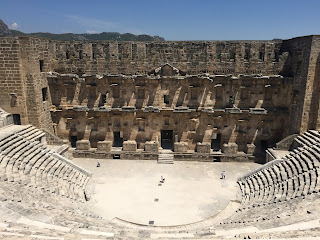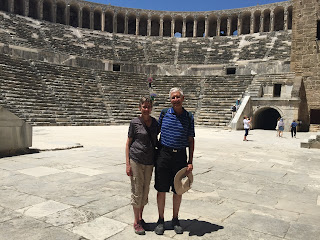Breakfast on the terrace was, again, very pleasant, but we could tell from the start that today was going to be a hot one. Indeed, it was 88F by noon. We had to walk out of Old Town, as the bus cannot get through the narrow, winding streets.
Our destination: the ancient ruins of Perga (PER-geh), only about 10 miles away but with morning traffic nearly an hour’s drive. Founded by Bronze Age Hittites, ruled by Persians, Greeks, Romans and Byzantines, Perga has been around a long time. But most of what is visible today dates from Roman times, roughly the 2nd century AD.
We had seen most of Perga’s treasures yesterday in the museum, but there is still plenty left to see. A fortified city gate still welcomes visitors. Just inside, a large agora is to the right and a huge, very well preserved Roman bath is to the left. We decided that, much like today, women probably went to shop while men waited at the bath, which also functioned very much as a men’s social club.
A bit farther in along the main street is the old Greek city gate. When the Romans expanded the walls they left this old gate in place. It no longer was part of the fortifications, but held many statues of the city’s founders, of emperors and their wives, and of the gods (now all museum pieces), so it served as a memorial.
The main street of Perga must have been a wonder to behold in its day. Gently sloping up hill toward the acropolis, it consisted of two wide lanes separated by a flowing stream of water. Along both sides were wide, covered sidewalks. The roof was held up by great marble pillars, and mosaics made up the walking surface.
At the top end of the street, a giant fountain issued the water that would flow down the median, and the fountain was fed by diverting water from a nearby river, which was also the waterway by which Roman ships brought goods up from the Mediterranean Sea.
Not much has been excavated on either side of this central thoroughfare, but digging here is still underway. It is unusual to be able to visit a still active archaeological site.
On the way out, we walked through the stadium — the city’s sports arena — also quite well preserved. There is also a theater here, but we did not visit it. There is another theater nearby, at another Roman city, Aspendos. We will visit there shortly. And besides, it’s getting very hot!
On the way to Aspendos we stopped at a very small restaurant (if one could even call it that — more like the front yard of a house, with tables and chairs). Here, two elderly women were rolling out dough and baking it over a wood fire. An elderly man was shuttling wood to the fire from a wood pile somewhere out back.
They were making gözleme, which is basically a “pancake” stuffed with cheese. They were delicious, and we each got two, served with a “salad” of fresh tomatoes, cucumbers, peppers, and olives, and accompanied by a fresh-squeezed mixture of orange and pomegranate juices, all for 20 Turkish Lira — about $3.35 U.S. Amazing!
Aspendos was not far from the restaurant. Very little has been excavated here, but the theater has been in almost constant use (though not always as a theater) since its construction 1800 years ago. It is, therefore, one of the best preserved Roman theaters we have seen anywhere.
Despite the heat, we climbed into the cavea, or seating area. Mark made it to the top, 40 rows up. Coming down was the difficult part. The pitch is steep and there are no railings, but the view from the top was worth the effort.
Aspendos is also known for its remarkably engineered aqueduct system, which remains largely intact. The bus drove us out to a place where we could get a panorama of the length, which unfortunately is difficult to capture in a photo. But we were also up close to a very small segment where we could see how it was built.
Back at the hotel by late afternoon, it was a good day to cool off at the pool. Our German friend was showing herself once again, but we ignored her and read our books. Then after showers, we adjourned to the bar across the street, where the local beer is incredibly cheap, the rock music is loud, and we are by far the oldest customers in the place. A great way to end a very hot day.
Our destination: the ancient ruins of Perga (PER-geh), only about 10 miles away but with morning traffic nearly an hour’s drive. Founded by Bronze Age Hittites, ruled by Persians, Greeks, Romans and Byzantines, Perga has been around a long time. But most of what is visible today dates from Roman times, roughly the 2nd century AD.
We had seen most of Perga’s treasures yesterday in the museum, but there is still plenty left to see. A fortified city gate still welcomes visitors. Just inside, a large agora is to the right and a huge, very well preserved Roman bath is to the left. We decided that, much like today, women probably went to shop while men waited at the bath, which also functioned very much as a men’s social club.
A bit farther in along the main street is the old Greek city gate. When the Romans expanded the walls they left this old gate in place. It no longer was part of the fortifications, but held many statues of the city’s founders, of emperors and their wives, and of the gods (now all museum pieces), so it served as a memorial.
The main street of Perga must have been a wonder to behold in its day. Gently sloping up hill toward the acropolis, it consisted of two wide lanes separated by a flowing stream of water. Along both sides were wide, covered sidewalks. The roof was held up by great marble pillars, and mosaics made up the walking surface.
At the top end of the street, a giant fountain issued the water that would flow down the median, and the fountain was fed by diverting water from a nearby river, which was also the waterway by which Roman ships brought goods up from the Mediterranean Sea.
Not much has been excavated on either side of this central thoroughfare, but digging here is still underway. It is unusual to be able to visit a still active archaeological site.
On the way out, we walked through the stadium — the city’s sports arena — also quite well preserved. There is also a theater here, but we did not visit it. There is another theater nearby, at another Roman city, Aspendos. We will visit there shortly. And besides, it’s getting very hot!
They were making gözleme, which is basically a “pancake” stuffed with cheese. They were delicious, and we each got two, served with a “salad” of fresh tomatoes, cucumbers, peppers, and olives, and accompanied by a fresh-squeezed mixture of orange and pomegranate juices, all for 20 Turkish Lira — about $3.35 U.S. Amazing!
Aspendos was not far from the restaurant. Very little has been excavated here, but the theater has been in almost constant use (though not always as a theater) since its construction 1800 years ago. It is, therefore, one of the best preserved Roman theaters we have seen anywhere.
Aspendos is also known for its remarkably engineered aqueduct system, which remains largely intact. The bus drove us out to a place where we could get a panorama of the length, which unfortunately is difficult to capture in a photo. But we were also up close to a very small segment where we could see how it was built.
Back at the hotel by late afternoon, it was a good day to cool off at the pool. Our German friend was showing herself once again, but we ignored her and read our books. Then after showers, we adjourned to the bar across the street, where the local beer is incredibly cheap, the rock music is loud, and we are by far the oldest customers in the place. A great way to end a very hot day.














1 comment:
Thanks for sharing all of this trip! Great fun to read and see what you two are doing these days! Looks like a great trip for sure!
Post a Comment